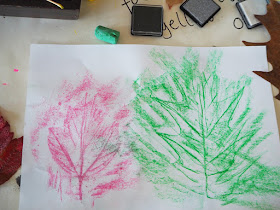The change in seasons can be a dramatic one, depending on where you live. Here in Australia, Autumn (Fall) is during the months of March, April and May and we actually have very few deciduous trees (trees that loose their leaves) that are native to our country. We do have some, but they are far outnumbered by the evergreen trees, so when we see the change in colour and pops of red, orange and yellow appearing on trees, they really stand out against the all the green.
To further investigate the changes happening around us and to inspire learning and creativity, I set up this Autumn Leaf Investigation Table for my kids. At ages 4 and 7, I knew that their experiences were going to be different to one another and that materials and even expectations had to be open-ended and able to be used in a way that interested them and was appropriate to their levels.
Unfortunately it took me so long to get around to sharing what we got up to, it is now Winter here! Whoops. We still have a number of brilliantly coloured leaves around, with the trees still continuing to drop their leaves so there's still time for investigating the Autumn leaves, even if it's not Autumn.
Ages: 3+ (see the bottom for tips to simplify or extend for your child's level)

Collecting a whole range of beautiful coloured leaves was the first step in creating our Autumn Leaf Investigation Table. I then added other materials to the table to inspire play and creativity.


I included a picture dictionary with related words as well as a couple of related nature word cards I had.


Creative materials like oil pastels, paint pens, ink pads and black paper were also added to the table.

Time to jump in!









As well as decorating some leaves, he even attempted some writing, inspired by wanting to try out fluro oil pastels on black paper. Yay!


She was very proud of her finished poem and has future plans for writing it up on a lovely leaf inspired artwork.
Handy Tips
- Simplify this activity for younger children by placing less of a focus on writing and more on exploring the leaves, colours, patterns and prints. It is still important to provide a text rich environment for children of all ages so having complimentary books/posters/word cards etc. is perfectly fine. You could include some larger words for tracing if you like.
- Extend this activity by:
- Brainstorming with children about all the words that come to mind when they think about "Autumn"
- Researching about Autumn in their area and the type of deciduous trees around (what resources could they use? Books, Internet, etc.)
- Encouraging children to write a story or poem based around Autumn
- Creating an Autumn inspired art work or song
- Sorting and classifying your collected leaves. What different groupings could they use? (shape, colour, size, etc.)
- Focusing on the science behind the change in leaf colours. (This could be through research, writing up a project, making a film documentary, etc.)
- Mix it up by adding in other materials like glue, string, scissors, paint, magnifying glass, beaker, water, etc. You can still do a similar exploration during any season of the year, it'll just end up with different focuses depending on the leaves you find and collect.
- Open Ended Invitations to Play and Explore are a favourite way of mine to set up an activity to entice learning. Here are a few more we've shared:
- Further Reading:
- Why aren't there more deciduous trees in Australia?
- The science of leaf colour change
- Leaf chromatography science project
Happy playing and creating,
Debs :)
Look where else we are. Are you following along? :)
New Here? Subscribe to get all activities sent directly to you

